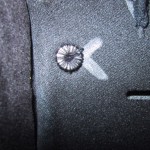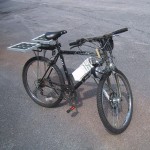The main problem I had with my previous ferrofluid test was that the magnets would repel each other enough that I was not able to achieve a single, solid object. After (mostly) cleaning the ferrofluid off of my magnets, I carefully removed half of the magnets and a washer, replacing them with a bit of Sculpey that weighted exactly the same. I pushed half of the magnets into the Sculpey, and then used them to hold another 17 magnets “outside” of the main body. This spacing keeps them far enough apart that they do not repel each other, and the Sculpey fills in the areas between the magnets.
The Sculpey will probably lose some weight when it is baked, but I’m counting on the ferrofluid to allow me to adjust the weight of the hanging object suitably. I don’t want to test it with ferrofluid until after I bake the Sculpey and coat it with black spray paint. The punk potato has a magnet with a plastic cap on it, so I needed to determine the lowest possible temperature that will harden the Sculpey without demagnetizing the magnet or melting the plastic cap. (Currently, the “punk potato” is right at the lower weight limit for successful levitation.) As the lowest curie temperature I could find for common rare-earth magnets was 310 °C, the plastic (which I assume is ABS, with a melting point of 105 °C, (or 220 °F) is my limiting factor. I set the oven to 215 °F and wrapped some tinfoil around the plastic in an attempt to protect it.
When I showed it to my wife she closed one eye, tilted her head, and said “Weird”, so I know I’m getting close to the aesthetic I’m aiming for.


